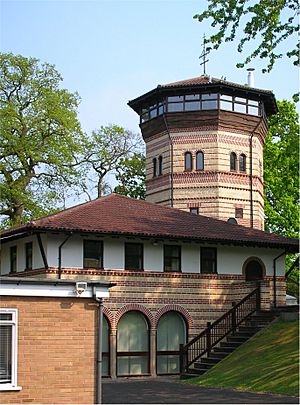Church of the Holy Prince Lazar, Birmingham facts for kids
Quick facts for kids Church of the Holy Prince Lazar |
|
|---|---|

The Church of the Holy Prince Lazar in Birmingham, England.
|
|
| Religion | |
| Affiliation | Serbian Orthodoxy |
| Leadership | Serbian Orthodox Church |
| Location | |
| Location | Bournville, Birmingham, England |
| Architecture | |
| Architect(s) | Dragomir Tadić |
| Architectural style | Serbo-Byzantine |
| Completed | 1968 |
| Materials | Brick, Stone |
| Website | |
| http://lazarica.co.uk/ | |
The Church of the Holy Prince Lazar is a Serbian Orthodox church in the Bournville area of Birmingham, England. It is often called Lazarica for short. This special church was built for people who had to leave their home country of Yugoslavia for safety after World War II.
The Serbian community has a long history in Bournville. During World War I, a kind woman named Dame Elizabeth Cadbury helped thirteen Serbian refugee children find a new home there. Later, the plan to build the church was supported by Prince Tomislav of Yugoslavia, who was living in exile.
Contents
A Special Building with a Rich History
The church was designed by an architect named Dr. Dragomir Tadić. It was built to look like a traditional church from 14th-century Serbia, using an ancient style called Serbo-Byzantine architecture. It was finished in 1968.
A Replica of a Serbian Church
Lazarica is a copy of a famous church in Serbia. To make it as authentic as possible, the builders used special stone and brick brought over from important religious sites in Serbia. The building has three beautiful sets of bronze doors and a large candle holder, also from Serbia.
One interesting feature is that there are no seats inside. This is common in traditional Orthodox churches, as people usually stand during the services.
What's Inside the Church?
The inside of the church is covered with amazing paintings. These murals were created using a technique called fresco. This means the artist painted directly onto wet plaster, so the colours became part of the wall itself.
The paintings show important figures and stories from Christianity.
- In the large dome on the ceiling, there is a picture of Christ Pantocrator (an image of Jesus as ruler of the universe).
- The half-dome above the altar shows the Virgin Mary.
- The walls are decorated with images of warrior saints, church leaders, and the apostles.
- There are also scenes from the twelve most important Christian holidays.
Next to the church is a cultural centre, which is recognized as a locally important building.
See also
- Serbian Orthodox Church
- Lazar of Serbia
- Serbs in the United Kingdom
- Church of the Dormition of the Mother of God, Osijek


